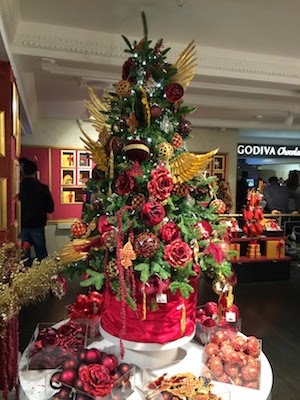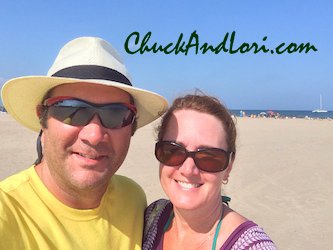 |
| Christmas Display at Harrods in London |
Happy Black Friday, everyone! May your deals be plentiful and sweet, and may your checkout lines move quickly!
We must admit, London was the perfect stopover to put us in the Christmas mood. We stepped off the train at Saint Pancras Station and right into the holiday spirit, from the gigantic Christmas tree at the station to the decorations everywhere we went the next week. There’s probably no better place, except perhaps home, to experience the holiday season than London, and that’s unfailingly because this was the epicenter of the Victorian Christmas Revolution.
Like it or not, Victorian England invented our modern, commercial and secular notions of celebrating Christmas, and it truly was a revolution, not an evolution (in more ways than one). Before the Victorian period, Christmas was barely recognized as a holiday. Most working people in Britain and America had to work on Christmas day, with church-going and a modest special dinner with immediate family conducted after work. Indeed, in many Puritan New England communities, celebrating Christmas was banned. There was no gift-giving: that was a practice held on New Year’s Day and limited to simple, hand-made crafts or candies. Americans are brought up with the notion of George Washington sacrificing his Christmas to cross the Delaware for a surprise attack on the British, but the truth is that most people–in England and the newly formed United States–worked that day anyway. All this changed during the Victorian era of the 19th century.
In many ways, it’s still easy to see how the Victorians defined the way we celebrate Christmas today. While the British have Father Christmas and the Americans have Santa Claus, for the most part we celebrate the holidays in the same ways and for about the same time period (for example, even without having the Thanksgiving holiday, the English have borrowed the concept of “Black Friday”, which demonstrates just how culturally and–especially–economically we’re linked).
But what changed in the Victorian era, and how did it come about? We’ll look into those questions in today’s and tomorrow’s blogs to (hopefully!) help you get into the holiday spirit.
The Victorian Era
| Queen Victoria, Prince Albert, and the first 4 of their 9 Princes and Princesses |
| Etching of the Royal Family Celebrating Christmas, 1848 |
| The Victorian Home at Christmas |
Combining the sudden, exploding love of decorating for Christmas with readily available and inexpensively manufactured decorations, the Victorian home was soon covered, almost literally, in festive decorations. “Deck The Halls” was not just a carol, but an integral activity referring to practically filling one’s home with garlands and sparkly decorations. Families began collecting heirloom decorations to use from year to year, and special plants–poinsettias, holly, and misteltoe–were acquired for mystical, if not simply nouveau tradition, reasons. The red berries of holly were said to ward off evil spirits and lightning, the latter no doubt the more frequent (and pragmatic) source of home tragedy than the former. Holly was accorded such special tradition, that it was carried in, almost ritually, by the men of the house.
Mistletoe deserves a special mention. It is known to have been used in ancient pagan (Druidic) rituals, and as such it was banned from most Christian churches, yet–perhaps in spite of religious mores–Victorians hung sprigs of it in their homes as part of their Christmas decorations. Norse tradition called for two warriors who meet under mistletoe growing high in a tree to declare a truce for the day: the affectionate Victorians replaced truce-declaring with a kiss. But for each kiss rendered under the mistletoe, a berry was removed. Once all the berries were gone, it no longer held its kiss-inducing sway. The Victorians loved games like this.
Obviously many of these myths and traditions have faded into history, but the practices remain whether we understand their origins and uses or not. But perhaps the best example of a tradition that we can appreciate and understand as equally as our Victorian ancestors who started them is the modern notion of the Christmas feast.
The Christmas Feast
 |
| The Victorian Christmas Feast |
Feasting obviously wasn’t invented by the Victorians, but what they feasted on established much of what we still feast on today. Before the Victorian era, remember that Christmas was mostly just another day, albeit a major Christian observance. Most people probably worked that day, so their evening meal was also likely what they had every day, or perhaps a splurge of a pheasant or larger-than-normal roast.
The industrial revolution, with the invention and mass production of farm implements and machines and means of transportation, resulted also in huge increases in agricultural productivity. Turkey became widely available and as much loved then as it is today. With increasing disposable income, more people were able to purchase or prepare the more “frivolous” components of the Christmas feast, namely figgie puddings (from the carol), fruit cakes, cranberry sauce, chestnuts (roasted, naturally), smoked salmon, and pies and cakes galore. Automation made the mass production of some foods, like confections, more and more affordable.
While the availability of local ingredients naturally influenced the development of some local traditions (minced pies comes to mind), the industrial revolution also made the world smaller. As a result, exotic fruits started showing up on the Christmas table. I remember my mother saying that each year she and her sisters would get a banana in their Christmas stocking as a special treat; even in the 1930’s such exotic fruits were still uncommon but available even in rural Alabama, at least come Christmas.
Tomorrow we’ll continue our exploration of how Victorian Christmas traditions influence our modern notions of Christmas by looking at Christmas cards, gift-giving, caroling and the unique music of Christmas, and story-telling.



